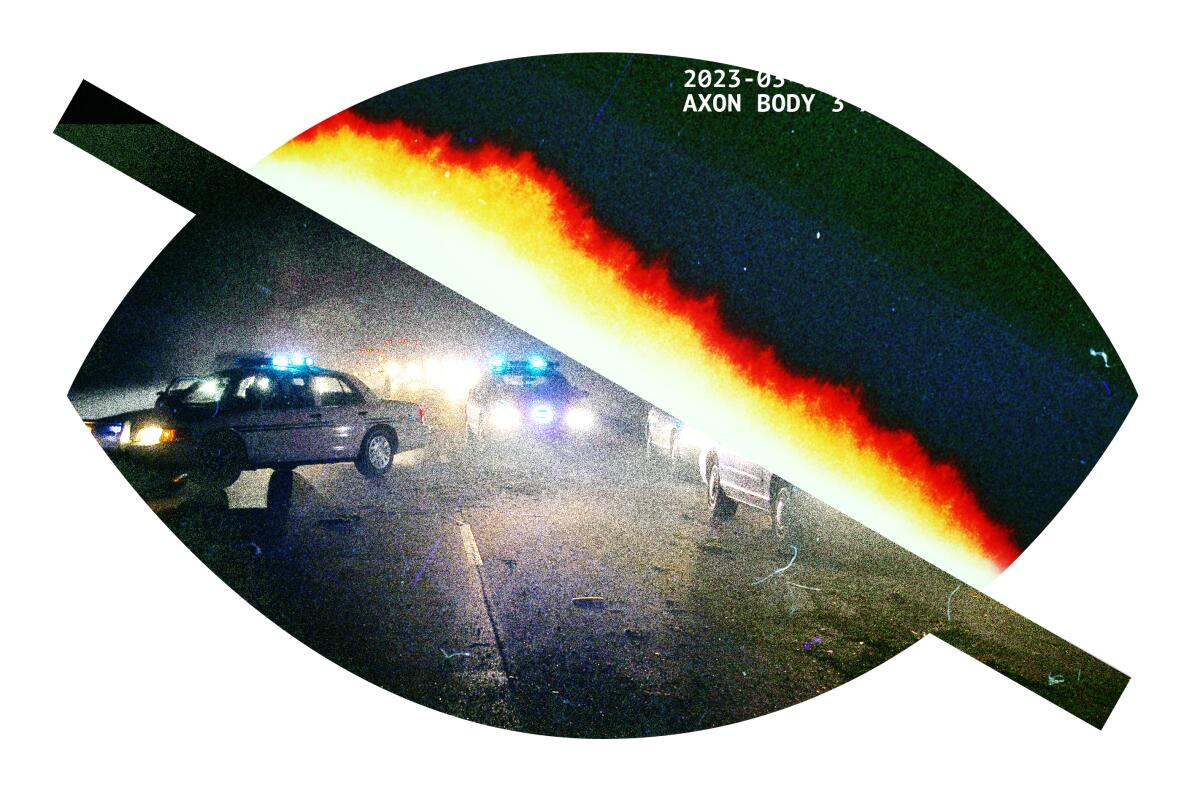How (not) to watch viral videos of police brutality

- Share via
WASHINGTON — Angela Blount doesn’t watch videos of police violence. She didn’t watch the video of Memphis, Tenn., police beating Tyre Nichols, a Black motorist who later died of his injuries. She didn’t watch the video of a Minneapolis police officer murdering George Floyd.
And she probably won’t watch the next viral video of a Black American being beaten or killed by law enforcement.
“I have a Black son and I have two Black grandsons. It would be like watching my own child or grandkids being beat to death,” she said. “I am 67 years old and I didn’t want to do that to my body, my mind, my spirit. I needed to protect myself.”
Videos of police violence have spurred change in Americans’ attitudes. But watching them can also do real harm.
“If you watch someone get murdered, of course, that might trigger some kind of traumatic response, certainly some anxiety,” said Adaobi Anyeji, a clinical psychologist and founder of the Blue Clinic, a psychology practice in downtown Los Angeles that specializes in anxiety and depression.
Even people who feel compelled to watch such videos may find it unpleasant or impossible to watch them at length, again and again, year after year.
For Aubrey Backus, a 25-year old Black man in Los Angeles, a short clip of the hourlong Memphis video was enough.
“I have pretty much seen this story and the same video over and over before,” he said. “I know for me personally, it is just tiring. Especially being a Black man, it is like watching myself get beat up or get killed by police. I don’t want to constantly see that, even though I know that’s happening.”
But videos of police beating or killing civilians can be hard to avoid. Here’s some guidance for handling them:
You don’t need to watch to be informed
Victims’ families and advocates hope publication of images and videos of graphic violence can lead to change. Sometimes that happens: Rosa Parks said that images of the mangled body of 14-year-old Emmett Till catalyzed her to refuse to give up her seat on a bus weeks later. Minnesota Gov. Tim Walz has said that without bystanders’ videos, the officers involved in Floyd’s murder would never have been convicted.
But sometimes videos of police brutality do not lead to accountability for the officers involved. Those seen beating Rodney King in a 1991 video, for example, were acquitted by a Superior Court jury. (They were later convicted by a federal jury).
You do not need to watch videos of police violence in order to be informed. You should know yourself and your limits before exposing yourself to distressing videos, says Arron Muller, a New York-based licensed clinical social worker whose clients are primarily Black men, women and children.
For some people, “watching it is unhealthy,” Muller said. “Do not feel that in order to be moved or to maintain your Blackness, you have to watch these images. [Not watching] does not negate your Blackness, does not negate that you care about it.”
People who want to stay informed about police violence but don’t want to watch graphic depictions of it can instead follow the story in the news, Muller said. If you feel called to action, taking part in peaceful rallies or writing letters to your elected officials can make a difference, he added. Most mainstream news outlets adhere to a strict ethical code and generally shy away from presenting distressing material while reporting accurately on the content of it.
Even though she did not watch the Memphis video, Blount said she managed to be informed about it by watching the eulogy delivered by the Rev. Al Sharpton at Nichols’ funeral and a television interview with Nichols’ mother, RowVaughn Wells.
“That broke my heart, and so I didn’t need to see the pictures,” Blount said. “I heard it from her.”
Don’t watch alone
If you choose to watch videos of violence, watch them with someone you trust in a supportive environment, Anyeji advised.
“When you choose people to watch it with, make sure it’s people that you have a relationship with, people that are compassionate and supportive,” she said.
She recommends drawing up a list of calming activities to do and questions to ask one another after watching a distressing video. If you are already in supportive treatment with a therapist, you can also bring it up with them.
“Have that kind of mapped out right before you watch ... so that when you watch the video, and it triggers all these responses that can be very distressing, very discombobulating, you already have a plan of what you are going to do in order to take care of yourself,” she added.
Muller recommends that you also write about your thoughts and feelings in a journal. For people of faith, he added, it can be helpful to pray “to center yourself.”
Check in with yourself after watching
When you watch a disturbing video, it is important to pay attention to your body and monitor for signs of distress, Muller said.
“Ensure that you are breathing, because sometimes, we pause, we tense. … Are you feeling chills? Do you feel hot? Wet palms? Because that may be anxiety,” he said.
Other signs of distress can be sleeping difficulties, changes in your diet, images replaying in your mind and an increase in your heart rate, Anyeji adds.
And if you don’t feel anything after watching someone get killed, that too is an important bodily response.
“When you have this feeling of apathy or numbness — you can’t feel anything — that’s also a signal that something is happening,” Anyeji said.
Engage in ‘GRAPES’ self-care
If you have been exposed to distressing video without seeking it and without a plan, Anyeji recommends remembering the self-care acronym GRAPES:
- G calls on people to be gentle and compassionate with themselves. “Don’t suggest that you should just snap out of it if you watch a video and it is really distressing to you.”
- R is for relaxation. Actively relaxing is more than just sitting behind the television. Engage in some meditation and deep breathing, take a walk outside, read or listen to soothing music. “These things will actively bring down your blood pressure, your heart rate, so they actually relax your body.”
- A is for accomplishment. Distressing videos can make it hard to complete even the most basic tasks. “For the next couple of days, it may be difficult to get your entire to-do list, so when you are able to do those things, acknowledge it, rather than beating yourself up about the things you can’t do.”
- P is for pleasure. “When you think about pleasure, you should really be thinking about using your senses to engage things that feel good.” That can include a special meal, a scented candle, incense or aromatherapy.
- E is for exercise. It doesn’t mean go to the gym and do an hour of cardio exercise. “Take the stairs, park your car a little bit further away so you can walk a little bit longer. Move your body. That gets endorphins going that are effective in helping your mood.”
- S is for socialize. Isolation can compound your distress, so connect with people to talk about how you are feeling. “Make sure you are thinking about people that are generally supportive, not people that will invalidate you.”
Set boundaries with people who share things with you
If you have received a distressing video from a friend or family member, it may be time to communicate your boundaries with them so that they know not to send something similar to you in the future.
“You should never apologize for setting boundaries. So feel reassured, knowing that if it is uncomfortable for you, you have every right to express that,” Muller said.
Anyeji says that the sender might be desensitized or numb to the disturbing content, which is also a sign of the sender’s traumatic distress, which they may unknowingly be passing along.
Muller recommended saying something like: “I kind of made a commitment to myself not to engage in any images and videos that make me feel uncomfortable. I would like it if you discontinued sending me anything with violence because it is not good for my mental health.”
Anyeji also suggests saying: “When you send such a video to me, of someone being murdered, it is actually really triggering for me. It is very difficult for me to
process and get through my day. Would you mind not sending things like that to me? I know that you are probably trying to just share information, but it’s very upsetting.”
More to Read
Get the L.A. Times Politics newsletter
Deeply reported insights into legislation, politics and policy from Sacramento, Washington and beyond. In your inbox three times per week.
You may occasionally receive promotional content from the Los Angeles Times.











